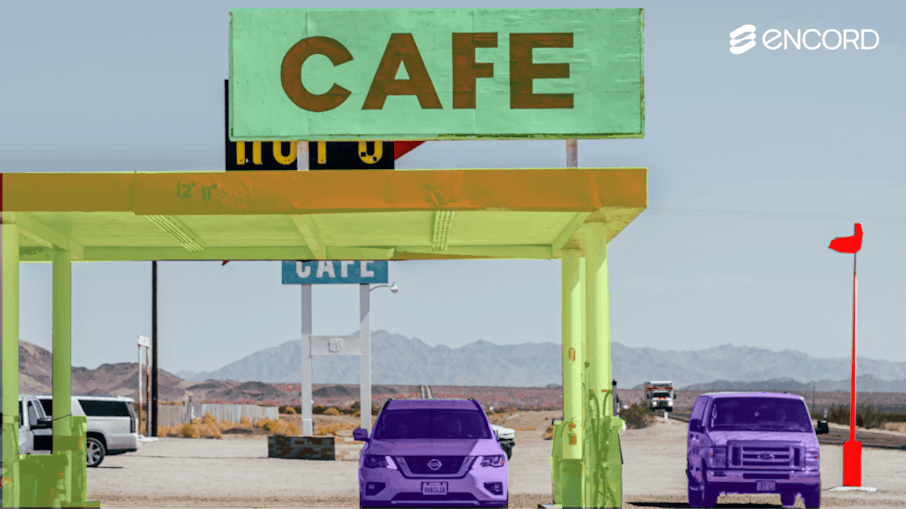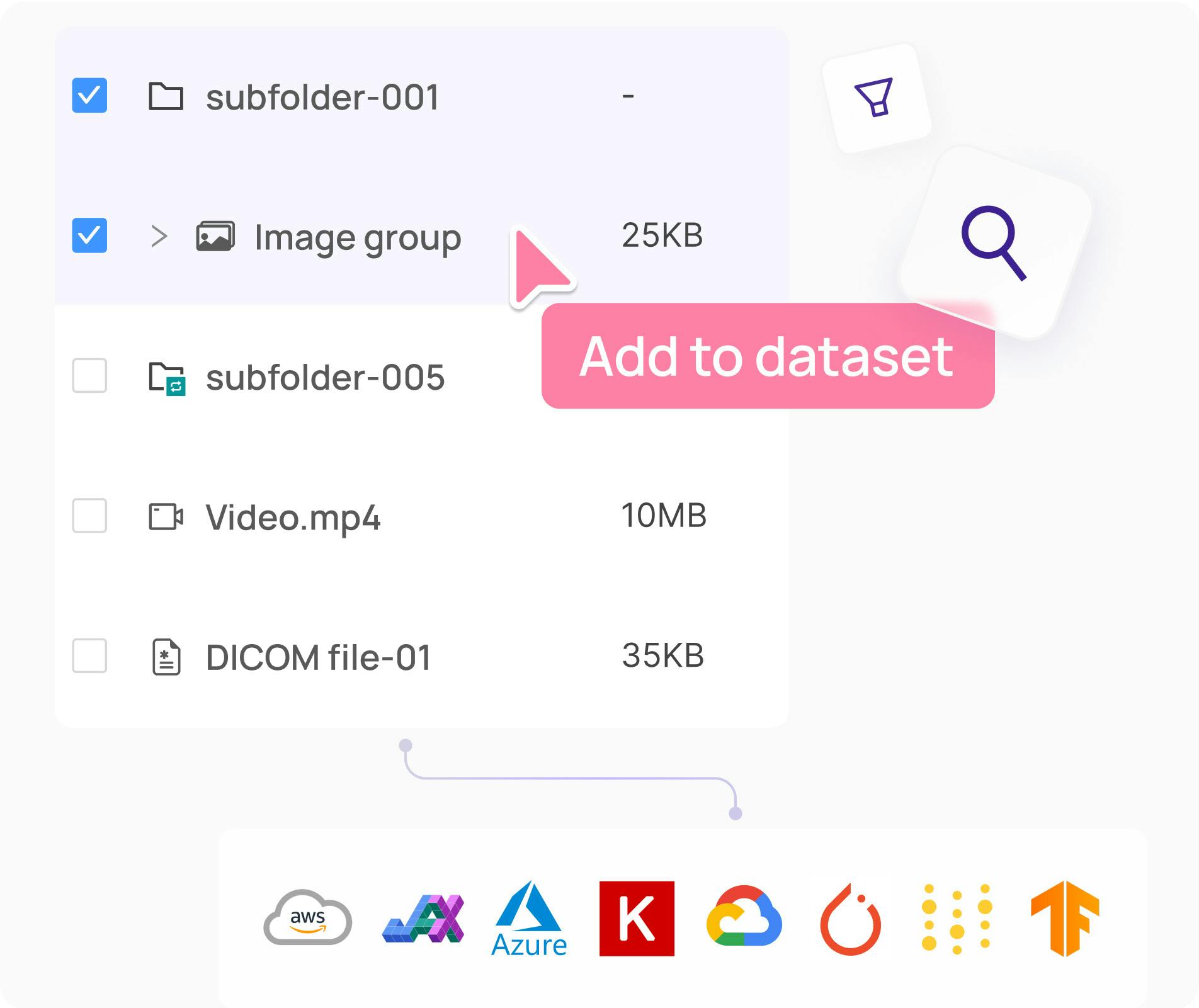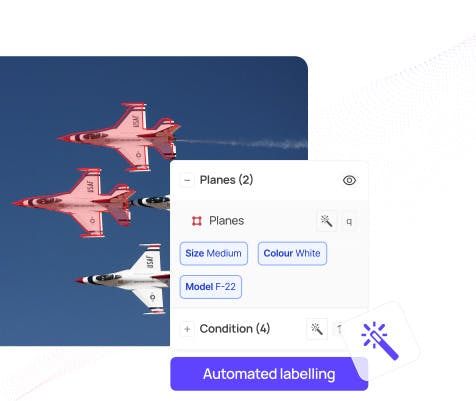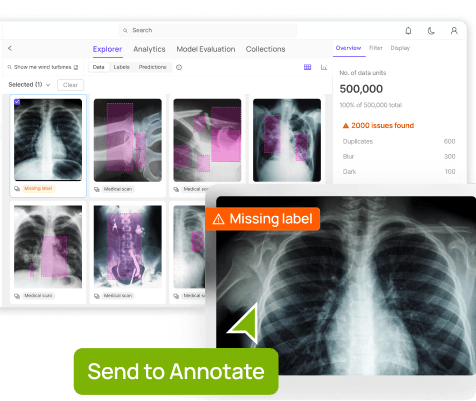Contents
What Is a Data Labeling Platform?
Why Data Labeling Platforms Matter
Top AI Data Annotation Platforms Compared
Best Platforms for Each Use Case
Encord Blog
Best Data Labeling Platforms for Each AI Use Case (2025)
5 min read

Data labeling is the backbone of all AI applications—from robotics and logistics to sports and generative AI. Encord stands out as the most complete platform, offering multimodal support, AI-assisted labeling, quality assurance, and enterprise-grade compliance. The right platform ensures scalable, precise datasets that power reliable, high-performance AI models across industries.
Data labeling plays a vital role in AI model development, no matter the application. From training self-driving cars using point cloud data to enhancing generative video systems with annotated audio, accurate labeling is a critical step in the AI lifecycle.
As a result, numerous platforms now provide data annotation platforms and services. However, selecting the right one can be difficult. While many solutions boast sophisticated labeling tools, only a select few deliver the multimodality, scalability, and security required for enterprise-grade projects.
In this article, we will break down the best data labeling platforms for specific use cases, such as logistics, robotics, smart cities, sports AI, and generative AI.
What Is a Data Labeling Platform?
A data labeling platform is software that enables teams to annotate, manage, and curate data for AI model training. Modern platforms handle diverse data types (images, video, text, audio, LiDAR, 3D, and medical formats) and provide workflow automation, AI-assisted labeling, and quality assurance. By transforming raw data into structured, model-ready datasets, these platforms are essential for building accurate and scalable AI systems in fields like robotics, smart cities, sports analytics, logistics, and generative AI.
Why Data Labeling Platforms Matter
Data labeling transforms unstructured information into a format suitable for AI model training. The quality of these annotations directly influences model accuracy. Precise labeling leads to stronger, more reliable outcomes.
However, not all labeling providers operate the same way; some focus on speed, others emphasize regulatory compliance, and a few optimize for seamless model integration.
Modern data labeling platforms enable teams to:
- Handle diverse data types, including images, video, text, audio, and medical formats such as DICOM and NIfTI
- Incorporate quality assurance processes and humans-in-the-loop (HITL) review
- Utilize AI-assisted labeling and active learning techniques
- Scale operations securely across global teams and environments
- Adapt across different industries and use cases
Top AI Data Annotation Platforms Compared
| Use Case | Best Data Labeling Platforms |
| Smart Cities | Encord, Sama, iMerit, Annotell, Snorkel AI |
| Logistics & Machinery | Encord, Segments.ai, Scale AI, Kili, CVAT |
| Sports AI | Encord, Segments.ai, Scale AI, Kili, CVAT |
| Physical AI & Robotics | Encord, Scale AI, SuperbAI, BasicAI, TrainingData |
| Generative AI | Encord, Scale AI, SuperbAI, BasicAI, TrainingData |
Best Platforms for Each Use Case
Healthcare
AI is transforming healthcare, enabling breakthroughs in disease detection, patient outcome prediction, treatment planning, and personalized medicine. However, the success of these AI models depends on the quality of labeled healthcare data.
In healthcare AI, systems rely on:
- Medical imaging data such as CT scans, MRIs, X-rays, and pathology slides for diagnostic model training
- Electronic Health Records (EHRs), clinical notes, and lab results to predict patient outcomes and support decision-making
- Multimodal datasets combining imaging, text, and sensor data for richer context in AI models
- Real-time monitoring data from wearables, vital signs, and telemetry for predictive healthcare analytics
- Anomaly detection across patient data, imaging scans, and clinical workflows to identify early warning signs of disease
The best data labeling platforms for developing healthcare AI include:
- Encord
- Labelbox
- SuperAnnotate
- Scale AI
- Amazon SageMaker Ground Truth
Smart Cities
AI is revolutionizing the way cities operate, powering advancements in traffic optimization, environmental monitoring, public safety, infrastructure management, and citizen engagement. However, the success of these intelligent urban systems hinges on the quality of their labeled data.
In smart cities, AI systems depend on:
- Video inputs from traffic cameras, CCTV networks, and public safety systems
- LiDAR, radar, and 3D point cloud data for mapping infrastructure, enabling autonomous mobility, and detecting obstacles
- IoT sensor and telemetry data monitoring water, energy, air quality, noise levels, and waste management
- GIS, geospatial, satellite, and aerial imagery used for urban planning, zoning, land assessment, and flood risk analysis
- Anomaly detection across utilities, environmental systems, and structural health monitoring
The best data labeling platforms for developing smart cities are:
- Encord
- Sama
- iMerit
- Annotell
- Snorkel AI
Logistics AI & Machinery
AI is revolutionizing logistics and automation, from autonomous forklifts and delivery drones to smart warehouse management and industrial process oversight. Yet, even the most advanced AI systems depend on one critical foundation: accurately labeled data.
High-quality training data is essential across all AI domains, but it becomes particularly vital in high-stakes environments like robotics and machinery. These systems often integrate multiple data types, combining robotics and computer vision, and rely heavily on precise labeling of video, imagery, and LiDAR inputs.
In logistics and automation, AI systems leverage:
- Video streams from warehouses, factories, and shipping hubs
- LiDAR and 3D point cloud data for navigation, mapping, and obstacle avoidance
- Sensor and telemetry data from robotic systems and conveyor networks
- RFID and barcode information for efficient inventory tracking
- Anomaly detection models for predictive maintenance and fault prevention
The best data labeling platforms for logistics and machinery applications are:
- Encord
- Segments.ai
- Scale AI
- Kili
- CVAT
Sports AI
From tracking every movement on the field to analyzing biomechanics frame by frame, Sports AI is transforming how athletes train and compete. None of this is achievable without precise, well-annotated datasets.
High-quality labeling is especially critical for sports AI, as models must handle numerous edge cases. These include varying lighting and weather conditions, as well as challenges like tracking and segmenting objects when occlusions occur.
Sports data presents unique challenges:
- Multiple camera angles requiring synchronization
- Fast-paced action with unpredictable player and ball movements
- Pose and skeleton annotations for biomechanics analysis and injury prevention
- Privacy considerations when handling biometric or medical information
The best data labeling platforms for sports AI are:
- Encord
- Segments.ai
- Scale AI
- Kili
- CVAT
Physical AI & Robotics
Robotics and physical AI systems rely on large, multimodal datasets that are meticulously labeled. Physical AI demands a rich understanding of visual, spatial, and temporal information, ranging from LiDAR scans and 3D point clouds to synchronized camera feeds, radar signals, and audio inputs. These require data labeling platforms with 3D & LiDAR functionality.
In applications such as drones, autonomous vehicles, and robotics, labeling accuracy is critical for safety. These platforms go beyond simple annotation, they serve as the backbone of robotics data operations, enabling teams to build, manage, and refine complex datasets while maintaining compliance, scalability, and operational efficiency.
In physical AI and robotics, AI relies on:
- LiDAR and 3D point clouds for mapping, navigation, and obstacle detection
- Synchronized camera feeds for visual perception, object recognition, and tracking
- Radar and sensors for detecting objects, distance measurement, and environmental awareness
- Multimodal sensor fusion combining all inputs to enable safe, autonomous decision-making
The best data labeling platforms for deploying physical AI are:
- Encord
- Scale AI
- SuperbAI
- BasicAI
- TrainingData
Generative AI
The performance of generative AI models depends entirely on the quality of their training data. Data labeling for GenAI goes beyond simple tasks like bounding boxes or semantic segmentation, it involves curating instruction datasets, reinforcement learning inputs, multimodal alignment, fine-tuning corpora, and evaluation pipelines.
For GenAI projects, you need labeling platforms that can:
- Manage multimodal data, including text, code, images, video, audio, 3D models, and medical formats
- Support LLM-specific workflows such as prompt-response annotation, red-teaming, and preference data collection
- Offer AI-assisted labeling through integrations with tools like ChatGPT, SAM, or Whisper to boost efficiency
- Scale securely with enterprise-grade infrastructure, ensuring compliance and reliability
- Provide quality assurance (QA) and collaborative features to maintain consistency across large, complex datasets
The best data labeling platforms for generative AI are:
- Encord
- Snorkel
- V7 Labs
- Labelbox
In summary, high-quality data labeling is the backbone of effective AI development. Choosing the right platform can make the difference between models that underperform and those that deliver accurate, reliable results. By understanding the strengths and focus areas of different labeling solutions, organizations can ensure their AI projects, whether in robotics, logistics, smart cities, sports, or generative AI, are built on precise, scalable, and high-quality datasets.
If you are looking for data labeling companies that provide services, explore the ten best video and image annotation companies in 2025 to help you with your search.
Explore the platform
Data infrastructure for multimodal AI
Explore product
Explore our products
- Encord supports multimodal annotation, AI-assisted labeling, QA workflows, and enterprise-grade compliance, making it suitable for large-scale, high-stakes AI projects.
- Yes—platforms like Snorkel, Scale AI, V7 Labs, Labelbox, and TrainingData excel in programmatic labeling, broadcast-scale data, collaborative workflows, or on-premise security depending on the use case.
- Some prioritize speed, others regulatory compliance, and some focus on multimodal or high-volume annotation. Choosing the right one depends on the project’s domain, scale, and security requirements.


